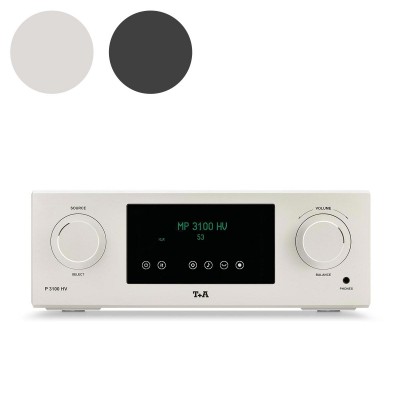The P 3100 HV Preamplifier
Preamplifiers are the most important components of any High-End system. Source devices connected deliver low-level signals to the preamplifier’s input section, and the unit’s task is to switch and amplify these signals, regulate their volume, process them where necessary and deliver them to the output sockets, ready for the power amplifiers. All this has to be accomplished without altering or falsifying the signals’ content. We have invested a vast amount of effort in designing preamplifiers which meet these requirements in full. The devices are of discrete, fully symmetrical construction, while every single component is the very finest available. The circuitry is housed in cases of uncompromising construction. The design and concept of the P 3100 HV is based on the P 3000 HV. Outwardly, the difference is only the type number. In terms of circuitry, however, the entire preamplifier section, and thus the most important part, has been further improved.
So far, the input and output stages of the P 3000 HV have been coupled to the relay volume control with high-quality capacitors. In the P 3100 HV a new, very complex circuit board layout compensates for the temperature coefficients of the transistors and the operating points can be set exactly, which means that the preamplifier stages have a pure DC coupling. There are no longer coupling capacitors in the signal path between the input stage, volume control and output stage. The preamplifier board is absolutely voltage and temperature stable. In addition, we have equipped the digital power supply with more power and shielded it even better. The already oversized toroidal transformer of the analogue part was enlarged to 115 VA. The sum of these measures leads to a significant improvement in sound quality.

High Voltage
In the ingenious overall circuit design of the HV (= High Voltage) series - developed in-house by T+A - all the amplifier stages operate at much higher operating voltages than usual: in the preamplifier the figure is up to 100 Volt, in the power amplifier up to 360 Volt. In a similar manner to valve amplifiers, the actual modulation of all the stages can be kept very low. Only a very small percentage (less than 20%) of the possible excursion of the amplifier transistors is used, thereby virtually eliminating the curvature (non-linearity) of that characteristic. Additional measures for improving the linear nature of the voltage amplifier stages are also employed. In addition to outstanding linearity, the high operating voltages employed offer the advantage of extremely wide dynamic range. We have developed this unique technology for use in all the HV-series machines, since the tremendous sonic improvements which it makes possible can be exploited in the output stages of source devices such as the MP 3100 HV multi-source player as well as in preamplifiers and power amplifiers.

Construction
The connector section on the back panel provides impressive evidence of the P 3100 HV’s uncompromising design and symmetrical double-mono construction. The channels are kept consistently separate. The preamplifier circuit boards are of exact identical construction, and are located under the case top cover; this layout eliminates electromagnetic influences. The circuit boards are housed in their own compartment made of thick-walled (10 to 15 mm) aluminium plates, and are completely separated and shielded from the mains unit and power supply in the bottom section of the case. The circuit topology is based on a differential cascode amplifier with hand-selected audio J-FET transistors. All stages are of completely discrete construction with-out op-amps (operational amplifiers). Their linear nature is not derived from “hard” negative feedback, as in the case of standard op-amps, but from the quality of the circuit topology and the components employed, which are carefully selected and adjusted. For this reason virtually no overall negative feedback is required. T+A HV technology enables signals up to 80 Vss to be processed without distortion - a value which is unique for a transistor preamplifier.

| Preamplifier Stage | |
| Frequency Response +0 / -3 dB | 0.5 Hz - 300 kHz |
| Signal to Noise Ratio - Unweighted / A-Weighted | 108 / 112 dB |
| THD | <0.001% |
| Intermodulation | <0.001% |
| Channel Separation | 108 dB |
| Unbalanced Inputs (RCA) | 7 x 250 mVeff - 9 Veff, 20 kOhms |
| Balanced Inputs (XLR) | 4 x 500 mVeff - 18 Veff, 5 kOhms |
| Outputs | |
| Headphones | 50 Ohms High Current |
| Recorder | 250 mVeff / 100 Ohms |
| Pre-Out - RCA | Nom. 1 Veff, Max. 9.5 Veff, 50 Ohms |
| Pre-Out - XLR | Nom. 1.45 Veff, Max. 19.6 Veff, 50 Ohms |
| Reservoir Capacity | 75,000 μF |
| Mains / Accessories / Dimensions | |
| Mains | 220 – 240 V, 50 Hz, 10 + 60 W Rated Current Consumption |
| Standby | <0.5 W |
| Features | Trigger Input +5 - 20 V for External Switching-On, Input 4 can be Configured in Surround Mode, Analogue Signal Processing Module, Slot for Optional Phono MM / MC. |
| Remote Control | F 3001 |
| Accessories | 2 x Power Cord, Remote Control Receiver E 2000 |
| Dimensions (H x W x D) | 17 x 46 x 46 cm |
| Weight | 28 kg |
| Finishes | Case: Silver Laquer (47) or Titanium Laquer (64), Heat Sink: Black (42) |
Write a Review
Note: If reviewing a product that has variations such as colour or length, please include this information at the start of the review. For example "Colour: Red" or "Cable Length: 2m" etc.
Your Name:Your Review: Note: Plain text only (HTML is not translated).
Rating: Bad Good





